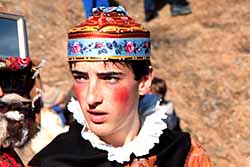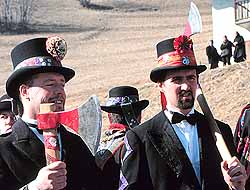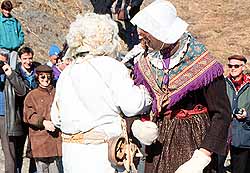La Béo di Blins

Blins è la variante occitana di Bellino, in alta Valle Varaita. Béo nel patois locale significa "abbadia"; questa festa si è svolta nelle borgate alte del comune, fino al 1958, tranne durante gli anni della seconda guerra mondiale, da centinaia di anni; è stata ripristinata dal 1999, è stata ripetuta nel 2000, e da allora avrà cadenza triennale.
Si svolge il giovedì e il martedì grasso. L’origine della festa è molto antica, non vi sono documentazioni scritte, secondo la memoria locale è legata alla cacciata del saraceni dalla valle.
La sfilata parte nel primo pomeriggio da Celle, attraversa Chiazale, arriva a Prafauchier e poi si conclude a celle in serata.
I personaggi sono:
- due Picounier, che aprono il corteo, hanno il compito di avvistare le barriere – tronchi messi di traverso sulla strada per impedire l’accesso – e avvisare gli altri;
- i Sapeur, che con le loro scuri abbattono le barriere che vi sono in vari punti del percorso (dopo l’ultimo colpo iniziano le danze, che coinvolgono tutta la popolazione, e vengono offerti dolci e vin brulé);
- lou Viei e la Viéio, coppia di anziani, con l’antico costume locale;
- le Sarazines, che danzano freneticamente facendo suonare i campanelli che portano appesi ai vestiti;
- l’Arlequin, con abiti multicolori e un cappello conico bianco con nastri, è sorvegliato da lou Soudà, con una divisa da alpino;
- lou Medic, che deve soccorrere la vecchia durante i suoi svenimenti;
- lou Gingòlo, che battendo due coperchi fa indietreggiare la folla troppo invadente;
- lou Cadet e l’Espouso, coppia di sposi in tenuta di nozze;
- lou Mounsù e la Damo, che rappresentano la borghesia;
- lou Turc, che ha un copricapo ricoperto di specchi, pronuncia parole incomprensibili e si agita passando vcino a una chiesa, quando sarà battezzato incomincerà a parlare l’occitano; è sorvegliato e portato in catene dal Carabinier;
- i Pourtatour del Ciciou, un pupazzo di paglia che viene bruciato la sera del martedì grasso per simboleggiare la fine del carnevale;
- i Sounadour, che accompagnano tutta la sfilata con musiche da ballo tradizionali.

|
Blins, the Béo feast

Blins is the occitan name of Bellino, in the high Varaita valley. Béo in the local language means "abbey". This feast was alive till 1958, then again in 1999 and 2000. From 2000 every three years.
The feast, like a parade, takes place on Thursday before Shrove Tuesday and on Shrove Tuesday. Its origins are very old: thus no written document has been found, the local tradition says that it is tied with the expulsion of the Saracens from the valley.

Characters:
- two Picounier (pickman), looking for wooden barriers (tree-trunks breaking the road)
- the Sapeur, cutting the barriers with their axes (when the barriers are definitively cut the dances start, with offerings of cakes and vin brulé -heated wine-)
- the Viei and the Viéio, an old man and woman couple, in the traditional dress
- the Sarazines (Saracens), frenetically dancing ringing little bells
- the Arlequin, with a multicoloured dress and a white conic hat
- the Medic (the doctor), helping the old women while she is swooning
- the Gingòlo, who controls the crowd beating two lids
- the Cadet and the Espouso (bride), a married couple with their wedding-dresses
- the Mounsù and the Damo, representing the middle class
- the Turc, with a hat covered with mirrors, speaking an incomprehensible language, tossing while passing near a church (he will be then baptised), conducted in chains by the Carabinier
- the Pourtatour del Ciciou (the men carrying the puppet), a straw puppet which will be burned on the Shrove Tuesday evening to symbolise the end of the carnival
- the Sounadour (the players), playing traditional dance music all along the passing
|